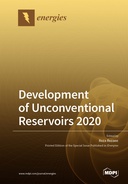Explore

Development of Unconventional Reservoirs 2020
Reza Rezaee (editor)
2021
0 Ungluers have
Faved this Work
Login to Fave
The need for energy is increasing and at the same time production from the conventional reservoirs is declining quickly. This requires an economically and technically feasible source of energy for the coming years. Among some alternative future energy solutions the most approachable source is from unconventional reservoirs. As the name “unconventional” implies it requires different and challenging approach to characterize and to develop such a resource. This special issue covers some of the technical challenges for developing unconventional energy sources from shale gas/oil, tight gas sand, and coalbed methane.
This book is included in DOAB.
Why read this book? Have your say.
You must be logged in to comment.
Rights Information
Are you the author or publisher of this work? If so, you can claim it as yours by registering as an Unglue.it rights holder.Downloads
This work has been downloaded 107 times via unglue.it ebook links.
- 107 - pdf (CC BY) at Unglue.it.
Keywords
- Abaqus
- adaptive filtering
- adsorption
- adsorption–desorption
- Alaska
- amorphous SiO2
- artificial neural network
- basement reservoir
- bedding fractures
- brittle spot identification
- brittleness
- Bumu region
- carbonate
- carbonate rock
- Carboniferous
- CBM
- CBM reservoir wettability
- CFD simulation
- classifications
- Clay minerals
- coal properties
- coal-bearing tight sandstone
- coalbed methane
- complex noise canceling
- complex rocks
- cross fractures
- CT
- deep learning
- depositional environments characteristics
- dimensional analysis
- discrete element method
- drilling
- dual media
- dynamic pore network modeling
- eastern Sichuan Basin
- elastic properties
- electrical conductivity
- electrohydraulic effect
- electromagnetic telemetry
- elliptical-shaped drainage
- enhanced oil recovery
- environmental implication
- EOR
- equilibrium height prediction model
- equilibrium proppant height
- estimation model
- Eulerian multiphase modeling
- failure criterion
- FEM
- finite element simulation
- fluids-rock interaction
- formation mechanisms
- fractal theory
- fractional derivatives
- Fracture
- fracturing fluids
- gas adsorption
- gas content
- gas controlling pattern
- gas diffusion
- gas geochemical characteristics
- gas hydrate
- gas loss
- gas viscosity
- geological structure
- Geology
- Gibbs excess adsorption
- gradient boosting decision tree
- group method of data handling
- heterogeneity
- heterogeneous sequence
- high voltage spark discharge
- history matching
- hong-che fault zone
- horizontal well with multiple finite-conductivity fractures
- hydraulic fracturing
- imbibition
- Induced seismicity
- influencing factor
- influencing factor analysis
- injection sequence
- irregular stimulated region
- Jizhong Sub-basin
- junggar basin
- kerogen porosity
- lamina
- Large Igneous Province (LIP)
- Lattice Boltzmann method
- lithofacies
- Machine learning
- main controlling factors of hydrocarbon accumulation
- matrix porosity
- mercury injection capillary pressure
- Methane
- methane adsorption isotherm
- MICP
- micro CT
- microseismic events
- modified fluid-mechanical coupling algorithm
- molecular simulation
- multi-fractured horizontal well (MFHW)
- multifractal analysis
- multifractured horizontal wells
- multistage fractured horizontal wells
- natural fracture
- natural gas hydrate
- network analysis
- neutral surface
- Neutron scattering
- NMR
- NMR measurements
- noble gas
- non-Darcy flow
- Northern Songliao Basin
- Numerical Simulation
- occurrence
- oil production
- Ordos Basin
- organic-rich clasts
- osmosis
- patent
- Permeability
- pore structure
- pore structures
- pore-scale
- porosity
- pressure waves
- pressure-dependent conductivity
- production analysis
- productivity forecast
- productivity index
- proppant transport mechanism
- proppant transportation
- pulse decay method
- quantitative analysis
- recurrent neural network
- Reference, information & interdisciplinary subjects
- Research & information: general
- reservoir characteristics
- reservoir properties
- rock damage
- rock physics
- Sample Size
- Saturation
- scanning electron microscope
- seismic attributes
- seismic interpretation
- seismic location
- seismic modeling
- SEM
- semianalytic model
- sensitivity analysis
- Shale
- shale gas
- shale gas evolution
- shale gas reservoir
- shale petroleum
- shale reservoir
- shale reservoirs
- solid-free drilling fluid
- stress shadow effect
- supercritical adsorption
- surfactant
- technological development
- Technology, engineering, agriculture
- Technology: general issues
- tectonic movement
- the Da’anzhai member
- thema EDItEUR::G Reference, Information and Interdisciplinary subjects::GP Research and information: general
- tight gas reservoir
- tight gas reservoirs
- tight oil
- tight sandstone
- turbulence effect
- umiat
- unconventional core
- unconventional formations
- unconventional gas reservoirs
- unconventional reservoir
- unstable productivity model
- void ratio
- void space structure
- volcanic reservoir
- vug
- water flooding
- water fracturing
- water imbibition
- water saturation
- wave velocity
- waveform stacking
- well logs
- well spacing
- Wheeler diagram
- X-ray diffraction
- X-ray fluorescence spectrometry
- Xujiaweizi Rift
Links
DOI: 10.3390/books978-3-0365-1754-4Editions

